UAVs, Drones, Remote Surveillance Tech
Re: UAVs, Drones, Remote Surveillance Tech
Solar Plane Aims for New Record: 3 Months Aloft Without a Pilot or Fuel.
http://www.popularmechanics.com/technol ... ck=pm_news
http://www.popularmechanics.com/technol ... ck=pm_news
Re: UAVs, Drones, Remote Surveillance Tech
European-Designed Robotic Underwater Vehicles That Can Work in Teams.
http://www.popsci.com/technology/articl ... work-teams
http://www.popsci.com/technology/articl ... work-teams
Re: UAVs, Drones, Remote Surveillance Tech
I wonder how India can get UCAVs in light of MTCR.I was just checking the MTCR provisions and they apply to UAVs also.vic wrote:The requirement seems to be for stealth UCAV with internal weapon bays which seems like overambitious as only USA seems to be close to deploying such systems. Problems with USA are well known. Basically IAF should split its requirement in 2 parts, One buy/assemble current UCAVs and another get into a future projectCraig Alpert wrote:AIRFORCE HUNTS FOR COMBAT DRONES
Current Main UCAVs are turboprop UCAVs being Reaper (USA), Heron TP (Israel) and Mantis (UK). There is off course Mantis (turbofan) but still under development and very little chance of getting Global Hawk, USA. India should leverage experience to further develop Rustom
The future Stealth Turbofan UCAVs are being projected by USA (Lockheed, Boeing & Northrop), UK (forgot name) and France (neuron). Logically Israel should have a programme but there is not even a whisper about it. India should leverage experience to further develop Aura
http://en.wikipedia.org/wiki/Missile_Te ... rol_Regime
From MTCR website
http://www.mtcr.info/english/index.html
Re: UAVs, Drones, Remote Surveillance Tech
SAGEM's own MALE uav completes fourth round of tests in France.
http://www.spacedaily.com/reports/MALE_ ... s_999.html
http://www.spacedaily.com/reports/MALE_ ... s_999.html
Re: UAVs, Drones, Remote Surveillance Tech
India develops better UAV landing software at Army institute of technology(AIT)
http://www.spacedaily.com/reports/India ... e_999.html
http://www.spacedaily.com/reports/India ... e_999.html
Re: UAVs, Drones, Remote Surveillance Tech
x-posting
New Terahertz Remote-Sensing Technique Can Detect Explosives, Drugs, etc
http://www.wired.com/wiredscience/2010/ ... detection/
http://www.dnaindia.com/scitech/report_ ... es_1408907
This reminds me a bit of the chemcam system developed by NASA for its upcoming Mars rover. I'm thinking that not only could this new Terahertz sensing method be useful for detecting explosives, but it could also be useful for analyzing rocks on the Moon or other planets. The Chandrayaan-2 rover will apparently be using something like chemcam, but perhaps this latest technique could be even better still. Maybe it's not too late to upgrade the planned instrument packages. This latest technology sounds like it could even work from orbit, and so you wouldn't have to equip it on the rover, but could just keep it on the Chandrayaan-2 orbiter.
The most productive use would be for remote intelligence gathering here on Earth. You could have a satellite or drone aircraft equipped with this technology, which would be able to gather more detailed information about a target it's monitoring.

New Terahertz Remote-Sensing Technique Can Detect Explosives, Drugs, etc
http://www.wired.com/wiredscience/2010/ ... detection/
http://www.dnaindia.com/scitech/report_ ... es_1408907
This reminds me a bit of the chemcam system developed by NASA for its upcoming Mars rover. I'm thinking that not only could this new Terahertz sensing method be useful for detecting explosives, but it could also be useful for analyzing rocks on the Moon or other planets. The Chandrayaan-2 rover will apparently be using something like chemcam, but perhaps this latest technique could be even better still. Maybe it's not too late to upgrade the planned instrument packages. This latest technology sounds like it could even work from orbit, and so you wouldn't have to equip it on the rover, but could just keep it on the Chandrayaan-2 orbiter.
The most productive use would be for remote intelligence gathering here on Earth. You could have a satellite or drone aircraft equipped with this technology, which would be able to gather more detailed information about a target it's monitoring.

Re: UAVs, Drones, Remote Surveillance Tech
Phantom Eye hydrogen-powered spy plane unveiled


Boeing has unveiled its unmanned hydrogen-powered spy plane which can fly non-stop for up to four days.
The high-altitude plane, called Phantom Eye, will remain aloft at 20,000m (65,000ft), according to the company.
The demonstrator will be shipped to Nasa's Dryden Flight Research Center in California later this summer to prepare for its first flight in early 2011.
It is a product of the company's secretive Phantom Works research and development arm.
Boeing says the aircraft is capable of long endurance flights because of its "lighter" and "more powerful" hydrogen fuel system.
The company explained in a statement that Phantom Eye was "powered by two 2.3 litre, four-cylinder engines that provide 150 horsepower each".
It is also very large, with a 46m (150ft) wingspan.
"It isn't built for stealth - it's built for endurance," Mr Haddox told BBC News.
Re: UAVs, Drones, Remote Surveillance Tech
http://www.defensereview.com/bae-system ... f-thunder/
Excerpt:
Excerpt:
The Taranis UCAV prototype looks like a cross between a Boeing B2 Spirit bomber and Northrop Grumman X-47B UCAS (Unmanned Combat Air System), and costs £143M (143 million pounds), or $215M (215 million dollars) at today’s monetary exchange rate–so it ain’t cheap. The Daily Mail reports that “experts” are classifying Taranis as a cutting-edge design “at the forefront of world technology and as advanced as any US development.” According to Nigel Whitehead, Group managing director of BAE Systems’ Programmes & Support business, “Taranis has been three and a half years in the making and is the product of more than a million man-hours”.
The goal of Taranis would appear to be to provide NATO air forces with an armed/weaponized unmanned low-observable fast jet that can effectively evade the latest advanced Russian and Chinese anti-aircraft/surface-to-air radar-guided missile systems and air-to-air radar and missiles, and then destroy enemy targets with minimal input from its human controllers. DefenseReview wonders whether or not Taranis is low-observable enough to effectively evade the Russian S-400 Triumf (NATO codename SA-21 Growler) air defense system. Only war will tell. If not, that’s a lot of time, money, and manpower down the drain.
-
David Siegel
- BRFite -Trainee
- Posts: 60
- Joined: 14 Apr 2010 07:40
Re: UAVs, Drones, Remote Surveillance Tech
India Expresses Interest In Fire Scout Sale
http://www.bharat-rakshak.com/NEWS/news ... wsid=13170
India is planning to issue a letter of request to the U.S government for a U.S. foreign military sale (FMS) of Northrop Grumman’s MQ-8B Fire Scout vertical takeoff unmanned aerial system (VTUAS).
The Indian government is expected to send a request via the U.S Embassy for FMS clearance, as “the technology is not for release,” an Indian navy official says. Northrop has made presentations on the system over the past few years to the Indian navy and army.
With homegrown insurgency a big concern in India, interest has emerged for the Airborne Standoff Minefield Detection System (Astamids), which has been demonstrated on Fire Scout.
“The insurgents lay mines to be remotely triggered four inches below the roads in the Eastern states of India,” an army official says. “The algorithms to locate IEDs [improvised explosive devices] through processing Astamids imagery will prove a boon to the paramilitary forces having to cope with this problem.”
The sensor’s primary function is to detect minefields in support of mobile ground forces in day and night conditions. It uses quad-prism aperture-splitting technology with the aid of an integrated illuminator and target laser rangefinder and designator. The 75-lb. electro-optical infrared/multi-spectral imaging payload can detect surface-emplaced and recently buried patterned mines, as well as randomly scattered mines. The payload also can be expanded to detect obstacles, combat vehicles, camouflaged objects and other combat targets.
With the support of the U.S. Navy, Northrop and its industry partners completed a set of Fire Scout flight demonstrations in the United Arab Emirates on July 14. The demonstrations included numerous takeoffs and landings in hot, windy and sandy conditions in temperatures as high as 47 deg. C (117 degrees F). The VTUAS also conducted various test flights at altitudes up to 3,000 meters (9,800 ft.). These demonstration missions included non-line-of-sight operations that showcased Fire Scout’s ability to operate autonomously in remote locations, and its FLIR Systems electro-optical/infrared sensing capabilities used to locate and acquire targets, according to a statement. The flights also demonstrated the vehicle’s real-time imagery-transmission capability.
Based on a Schweizer Aircraft commercial helicopter airframe, the Fire Scout incorporates reliable turbine power (160 million flight hours) using standard NATO heavy fuel.
Meanwhile, the Indian government’s decision to convert its Alouette III light utility helicopters — known in India as the Chetak helicopter — into UAVs is in abeyance for the moment. A year and a half ago, there was a plan for the Chetak to be fitted with the sensor suite of the Israel Aerospace Industries (IAI) Heron UAV and an IAI-developed, bolt-on flight control package.
Chetak has been primarily in service with the Indian air force in training, light transport, casualty evacuation, communications and liaison roles.
Fire Scout photo: Northrop Grumman
http://www.bharat-rakshak.com/NEWS/news ... wsid=13170
India is planning to issue a letter of request to the U.S government for a U.S. foreign military sale (FMS) of Northrop Grumman’s MQ-8B Fire Scout vertical takeoff unmanned aerial system (VTUAS).
The Indian government is expected to send a request via the U.S Embassy for FMS clearance, as “the technology is not for release,” an Indian navy official says. Northrop has made presentations on the system over the past few years to the Indian navy and army.
With homegrown insurgency a big concern in India, interest has emerged for the Airborne Standoff Minefield Detection System (Astamids), which has been demonstrated on Fire Scout.
“The insurgents lay mines to be remotely triggered four inches below the roads in the Eastern states of India,” an army official says. “The algorithms to locate IEDs [improvised explosive devices] through processing Astamids imagery will prove a boon to the paramilitary forces having to cope with this problem.”
The sensor’s primary function is to detect minefields in support of mobile ground forces in day and night conditions. It uses quad-prism aperture-splitting technology with the aid of an integrated illuminator and target laser rangefinder and designator. The 75-lb. electro-optical infrared/multi-spectral imaging payload can detect surface-emplaced and recently buried patterned mines, as well as randomly scattered mines. The payload also can be expanded to detect obstacles, combat vehicles, camouflaged objects and other combat targets.
With the support of the U.S. Navy, Northrop and its industry partners completed a set of Fire Scout flight demonstrations in the United Arab Emirates on July 14. The demonstrations included numerous takeoffs and landings in hot, windy and sandy conditions in temperatures as high as 47 deg. C (117 degrees F). The VTUAS also conducted various test flights at altitudes up to 3,000 meters (9,800 ft.). These demonstration missions included non-line-of-sight operations that showcased Fire Scout’s ability to operate autonomously in remote locations, and its FLIR Systems electro-optical/infrared sensing capabilities used to locate and acquire targets, according to a statement. The flights also demonstrated the vehicle’s real-time imagery-transmission capability.
Based on a Schweizer Aircraft commercial helicopter airframe, the Fire Scout incorporates reliable turbine power (160 million flight hours) using standard NATO heavy fuel.
Meanwhile, the Indian government’s decision to convert its Alouette III light utility helicopters — known in India as the Chetak helicopter — into UAVs is in abeyance for the moment. A year and a half ago, there was a plan for the Chetak to be fitted with the sensor suite of the Israel Aerospace Industries (IAI) Heron UAV and an IAI-developed, bolt-on flight control package.
Chetak has been primarily in service with the Indian air force in training, light transport, casualty evacuation, communications and liaison roles.
Fire Scout photo: Northrop Grumman
Re: UAVs, Drones, Remote Surveillance Tech
British firm QinetiQ on Friday announced that its Unmanned Aerial Vehicle (UAV) Zephyr, a leading solar powered high-altitude long-endurance (HALE) aircraft, has been “smashing a number of long-standing world records,” particularly for its record non-stop flight time of over seven days.
According to a statement by the UAV's producer, the drone is currently flying high above the U.S. Army's Yuma Proving Ground in Arizona, where the Zephyr has already passed the seven day (168 hour) mark. QinetiQ noted that this doubled the unofficial world record for longest duration unmanned flight of 82 hours, 37 minutes set in 2008 — also held by Zephyr — and was “well in excess of the current official world record of 30 hours 24 minutes set by Northrop Grumman's RQ-4A Global Hawk on 22 March 2001.” Endurance flying of this sort, said the company, would be useful for an aircraft that was required to provide a low-cost, persistent surveillance capability over months rather than days. “Potential applications include earth observation and communications relay in support of a range of defence, security and commercial requirements,” QinetiQ said in a press release.The latest “green” model is around 50 per cent larger than the previous Zephyr, its producer said, and unlike conventional manned or unmanned aircraft now being operated, “Zephyr does not need to return to base at regular intervals for re-fuelling or servicing which also helps minimise the logistical supply chain and extend its operational capability.”
http://www.hindu.com/2010/07/18/stories ... 691600.htm
-
Craig Alpert
- BRFite
- Posts: 1440
- Joined: 09 Oct 2009 17:36
- Location: Behind Enemy Lines
Re: UAVs, Drones, Remote Surveillance Tech
UAVs Failed to Make to Monitor Movement of Naxals
Wonder what happen to the SAAB's CARABAS radar, for which the DRDO scientists were given SOURCE CODES to modify it suitable to Indian requirements/conditions??.................
We have not been able to acquire any such equipment... surveillance equipment... which would tell the movement of people from air borne vehicles... UAVs... from under the cover of thick foliage," Additional Director General of Bureau of Police Research and Development (BPRD), P C Sabarwal, said at an internal security conference here.The BPRD is the national agency under the central government which looks after modernisation of police forces and takes up new areas of research in subjects related to policing.
Sabarwal also said no service provider offering security gadgets have been able to come up with a solution to defuse and detect Improvised Explosive Devices (IEDs) and landmines buried 15 feet or deeper in areas of combat including Naxal zones.
"To our disappointment none of the service providers could come up with a solution (to counter these IEDs)," Sabarwal said while speaking at a CII conference on "Safe city- securing your world" and other internal security related issues.
I would request the participants (business representatives) to apply their mind according to our requirements. We are open to all new ideas and suggestions, he said.The Chhattisgarh government and the Centre earlier had carried out a test of a UAV manufactured by an American company, which was used by the US troops to track down Taliban militants.
This was done in the aftermath of the Dantewada incident where 75 CRPF personnel and a state policeman were killed in a deadly Naxal ambush on April six.Officials had successfully flown the UAV over the dense forests of Bastar in the first trial run for anti-Naxal operations, but the Chhattisgarh government wants to re-test the pilotless planes after the monsoon rains, which will make the jungles even more dense.
.............
-
Craig Alpert
- BRFite
- Posts: 1440
- Joined: 09 Oct 2009 17:36
- Location: Behind Enemy Lines
Re: UAVs, Drones, Remote Surveillance Tech
Spy in the sky  (really who comes up with titles like this?): India begins hunt for mini ‘killer’ drones
(really who comes up with titles like this?): India begins hunt for mini ‘killer’ drones
NEW DELHI: After launching the hunt for combat drones, the Indian armed forces are now looking to induct micro and mini UAVs (unmanned aerial vehicles) for snooping missions. Plans are even afoot to induct small UAVs which can perform "a killer role".
The IAF, for instance, has now issued an RFI (request for information) to armament companies for micro UAVs with an "operational endurance in excess of 30 minutes" but weighing less than two kg to ensure they can even be operated by a single person.
IAF wants these micro drones, with fuel or battery operated engines and latest avionics, to be capable of being "hand-launched" or with "vertical take-off and landing" capabilities. As per specifications, they should be equipped with CCD (charged-coupled device) cameras and FLIR (forward-looking infra-red) payloads.
This comes even as the 1.13-million Army is on course to induct slightly bigger mini and micro spy drones in a major way for short-range surveillance and intelligence-gathering missions as well as detection of NBC (nuclear, biological, chemical) contaminants in the battlefield.
The force wants some of these man-portable spy drones to be capable of even hitting small but high-value enemy targets with explosives in a Kamikaze fashion. This is in keeping with Army's plan to induct such UAVs in phases right down to the battalion-level by the end of the 12th Plan (2012-2017).
Being stealthy because of their small size, these drones will also be used to equip Army's Para (Special Forces) battalions for covert missions beyond enemy lines, counter-terrorism operations and `beyond-the-hill' surveillance.
This comes soon after IAF issued a global RFI to armament giants worldwide for procurement of combat drones or UCAVs (unmanned combat aerial vehicles), with precision weapons and satellite data links, drawing lessons from the deadly use of American `Predators' and `Reapers' against the Taliban in the Af-Pak region, as earlier reported by TOI.
Since the 1999 Kargil conflict, India has inducted over 100 Israeli UAVs and uses them in surveillance and precision-targeting roles. The armed forces also have some "killer" drones like Israeli Harpy UAVs, while more advanced ones like Harop have also being ordered. But UCAVs are a generation ahead since like fighter jets they come back to their bases to re-arm themselves with more missiles for the next mission.
* Drones are major force-multipliers since they can snoop with their sensors and cameras, as also send back real-time imagery to direct precision fire at enemy locations. Some even act as missiles to hit high-value targets
* Drone technology is moving towards combat UAVs (like American Predators and Reapers armed with Hellfire missiles) as well as mini ones
* Mini UAVs can evade enemy radars, are easy to handle and can be launched without runways. Some are so small that they can fit inside the palm of a hand
* Some mini UAVs even have sensors to detect IEDs (improvised explosive devices) and move ahead of a convoy of soldiers on surveillance missions
Re: UAVs, Drones, Remote Surveillance Tech
A few Indian companies have Micro UAVS in their listings.
MKU is a big one.
MKU is a big one.
Re: UAVs, Drones, Remote Surveillance Tech
^^^ Who are the non-military users? Politicians?

I can see ruling party wanting to use this technology to snoop on political opponents.“The requirement for these micro vehicles is very huge among non-military users, and hence the onus is more on the NP-MICAV team,”
Re: UAVs, Drones, Remote Surveillance Tech
Well, "non military users" may refer to CPOs?Sanjay M wrote:^^^ Who are the non-military users? Politicians?
I can see ruling party wanting to use this technology to snoop on political opponents.“The requirement for these micro vehicles is very huge among non-military users, and hence the onus is more on the NP-MICAV team,”
Re: UAVs, Drones, Remote Surveillance Tech
I think India should really develop the UCAV in house.... If we try to source it from someone.. well firstly no one will want to part with such tech, secondly we would be perennially dependent on them for such tech and will NEVER bother to develop these tech at home... effectively we will be outsourcing our future to them because UCAV etc is THE future so no point in playing catch up. Lastly it will be a white elephant in our hangers even if we buy it. What's the point when we dont effectively use the military assets we have already ? Lets see how well we use Pak-Fa etc, what we learn... also we have a good population, why not use the best minds available first before we go for unmanned combat drones... we might as well try for predator and global hawk variants first...
Re: UAVs, Drones, Remote Surveillance Tech
Northrop Grumman moved from Pegasus Arrow head form X-47A to X-47B maybe to suit the carrier based operation. It has both good high speed & low speed handling qualities. According to Bill Sweetman the same design of X-47B was used for the Next Generation Bomber. Though old news but the similarity of Aura project which resembles like X-47B kindles some interest.Juggi G wrote:With Cold Response To UCAV Query, IAF Throws Weight Behind Indian Programme
Shiv Aroor
http://www.aviationweek.com/aw/jsp_incl ... %20Stealth
This approach emerged from J-UCAS, and particularly from Northrop Grumman, which anticipated the J-UCAS split and was prepared to respond. The company believed that the basic 42,000-lb. J-UCAS was better suited to the Navy than to USAF, had focused on the carrier-based J-UCAS demonstration and picked a design that offered high lift and a simple wingfold.
Northrop Grumman's proposal for a bigger X-47C also preceded -- and may have inspired -- USAF's switch to a larger long-range bomber. This meant, too, that the NGB program could get a running start because it would use aerodynamics and stealth technology that were in the works for J-UCAS.
The X-47B was much more advanced, in aerodynamic terms, than it appeared (see sidebar), and the same is likely true of its low-observable (LO) qualities. The aircraft is one of the first to combine a highly blended tailless configuration with new materials developed since the 1980s. The NGB will be the same, if not more so.
Northrop Grumman has stressed the "all-aspect, broadband" stealth inherent in the X-47B. Tailless shapes don't have the "bow-tie" RCS pattern, with the smallest RCS on the nose and tail and peaks on the beam configurations, which characterizes conventional aircraft. They are stealthier against low-frequency radars -- including updated, active-array VHF radars marketed by Russia -- because they do not have shape features which are so small that their RCS in the VHF band is determined by size, rather than shape or materials. It may be significant that John Cashen, leader of the B-2 signatures team, returned in 2006 after 10 years in Australia and is now a consultant for Northrop Grumman.
RCS test facilities across the U.S. have been upgraded since the F-22 and B-2 were designed: USAF's range at Holloman AFB, N.M., was reequipped to handle bistatic measurements, and a sophisticated airborne RCS measurement program based on a modified 737 was delivered in 2001.
How low can LO go? One paper, co-authored by a principal in DenMar Inc., the company founded by Stealth pioneer Denys Overholser, refers to the development of fasteners for a body with an RCS of -70 dB./sq. meter -- one-thousandth of the -40 dB. associated with the JSF, and one-tenth that of a mosquito. DTI queried RCS engineers who don't believe such numbers are possible; but then, when mention of a -30 dB. signature leaked out in a 1981 Northrop paper, nobody believed that either.
Re: UAVs, Drones, Remote Surveillance Tech
traffic monitoring, patrolling, disaster management and the list goes.Sanjay M wrote:^^^ Who are the non-military users? Politicians?
I can see ruling party wanting to use this technology to snoop on political opponents.“The requirement for these micro vehicles is very huge among non-military users, and hence the onus is more on the NP-MICAV team,”
-
Craig Alpert
- BRFite
- Posts: 1440
- Joined: 09 Oct 2009 17:36
- Location: Behind Enemy Lines
-
Craig Alpert
- BRFite
- Posts: 1440
- Joined: 09 Oct 2009 17:36
- Location: Behind Enemy Lines
Re: UAVs, Drones, Remote Surveillance Tech
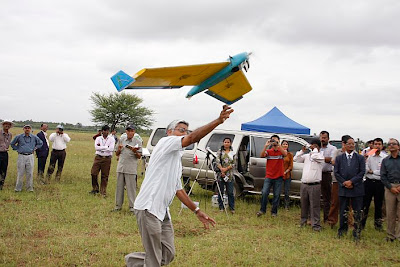
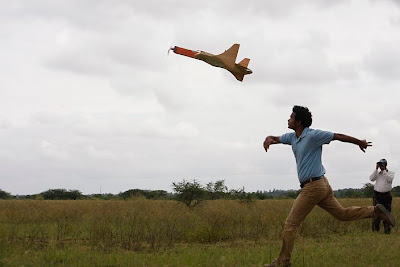

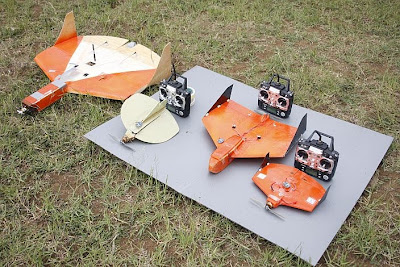
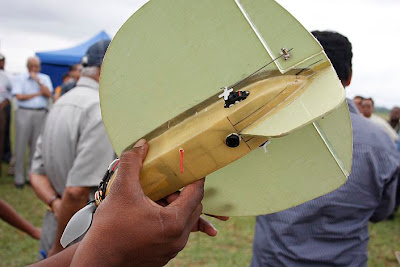
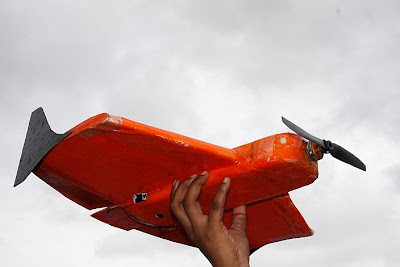
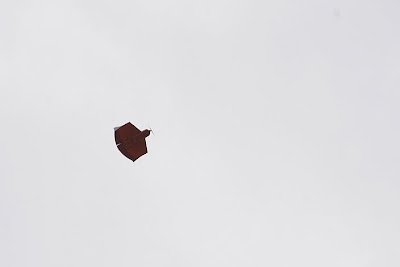
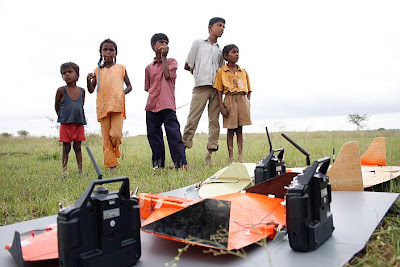
India Test Flies Five Micro Air Vehicles
Wonder what materials they used to build these?? Carbon Composites should be ideal, as long as they can withstand bullets from standards AK-'s and 9MM, but judging from these pics, it looks like they used cheap plastic and cardboard rather than composites atleast on the small yellow and the orange ones... (The blue and yellow combo looks like a decent MAV)
Re: UAVs, Drones, Remote Surveillance Tech
I would be surprised if any MAV in the world can resist Ak and 9mm bullets
Re: UAVs, Drones, Remote Surveillance Tech
Craig,
Small arms fire should not be a great concern. I don't know about these UAVs in particular but if we go by other micro UAV's in service , they fly too fast (65km/hr to 120 km/hr as per wiki articles) to be easily shot down by small arms. Considering their size, speed and height of flight they would be like speck of dust zooming across the sky. So, it would be highly unlikely for them to be shot down IMO. Of course, there is always a small possibility of the person firing the small arm getting lucky, but IMHO the benefit/cost ratio would be too low to make our micro UAVs bullet proof (by using carbon composite or any other method).
Small arms fire should not be a great concern. I don't know about these UAVs in particular but if we go by other micro UAV's in service , they fly too fast (65km/hr to 120 km/hr as per wiki articles) to be easily shot down by small arms. Considering their size, speed and height of flight they would be like speck of dust zooming across the sky. So, it would be highly unlikely for them to be shot down IMO. Of course, there is always a small possibility of the person firing the small arm getting lucky, but IMHO the benefit/cost ratio would be too low to make our micro UAVs bullet proof (by using carbon composite or any other method).
Re: UAVs, Drones, Remote Surveillance Tech
Iran unveils first bomber drone

Link - http://www.bbc.co.uk/news/world-middle-east-11052023
Iran has unveiled what it says is its first domestically built unmanned - or drone - bomber.
Iranian state TV later showed the "Karrar" aircraft in flight.
It said it had a range of 1,000km (620 miles) and could carry two 250-pound (115kg) bombs, or a precision bomb of 500 pounds.

Link - http://www.bbc.co.uk/news/world-middle-east-11052023
Iran has unveiled what it says is its first domestically built unmanned - or drone - bomber.
Iranian state TV later showed the "Karrar" aircraft in flight.
It said it had a range of 1,000km (620 miles) and could carry two 250-pound (115kg) bombs, or a precision bomb of 500 pounds.
Re: UAVs, Drones, Remote Surveillance Tech
Livefist: IIT-Kanpur To Help Create Indian UCAV
The Indian Institute of Technology, Kanpur (IIT-K) will now help develop critical technologies for AURA, India's concept UCAV programme. Sources tell me aerospace researchers at IIT-K (some of the best in the country, incidentally), have been given research work worth almost half-a-million dollars, and will soon get even more.
Re: UAVs, Drones, Remote Surveillance Tech
U.S. military to covertly deliver payloads with robot droness

more:
http://www.engineeringtv.com/video/V-Bat-VTOL-UAV

Called the V-Bat, the rocket-shaped robot is able to take off vertically like a Harrier jet and can autonomously proceed to its destination, as long as it takes less than five hours to fly there. It can cover a pretty large area considering it can work itself up to speeds of 140 miles per hour, though it can only carry around five pounds of gear.
more:
http://www.engineeringtv.com/video/V-Bat-VTOL-UAV
Re: UAVs, Drones, Remote Surveillance Tech
Israeli MAV superior than US’
THE Centre is in talks with an Israeli firm for acquiring micro-aerial vehicles (MAVs) that can detect landmines embedded up to 10 feet deep.
During live trials, US-based Honeywell Aerospace’s micro-aerial vehicles, T-Hawk, could detect landmines planted only just about a feet beneath the ground. It also proved ineffective in areas with thick foliage. The company plans to conduct retrials to address the shortcomings.
The home ministry and central para-military forces are impressed with the Israeli micro-aerial vehicles, whose video demonstrations show it to be far more effective in detecting mines.
The video demonstrations of the Israeli micro-aerial vehicles were conducted almost a month back at the Counter-Terror and Jungle Warfare College in Kanker. The micro-aerial vehicles detected mines up to 10 ft deep. THawk, in contrast, was unable to see through thick foliage, a common feature in the jungles of Chhattisgarh, rendering it useful only in regions such as North Bastar.
The Israeli micro-aerial vehicles are also capable of taking images with a resolution higher than the Honeywell micro-aerial vehicles. Even though the Israeli micro-aerial vehicles can also fire at target and fly back 10 feet to escape damage in the resulting explosion, this feature will not be put to use as there is no mandate yet to use airpower against Maoists.
According to sources, ministry of home affairs and central forces, impressed with the video demonstration, may now send a team of officers to Israel to see live trials. The Chhattisgarh government, which studied the video, too is appreciative of the capabilities of the Israeli micro-aerial vehicles. It would have ideally liked to procure at least 3-4 micro-aerial vehicles but for the precondition laid by the manufacturer that a minimum of 10 MAVs would have to be ordered.
By all means, it is a tall order for Chhattisgarh, given that the cost of each Israeli microaerial vehicle is estimated at 30 crore and a 10-micro-aerial-vehicles contract would set it back by nearly 300 crore, one-third of Chhattisgarh’s policing budget.
At least 20 MAVs would be needed for a region as vast as Bastar, making the procurement costs unwieldy. This essentially means that procurement of micro-aerial vehicles was best left to central forces such as the Central Reserve Police Force and the Border Security Force, active in the counter-Naxal grid.
Re: UAVs, Drones, Remote Surveillance Tech
From above link ^^^
Couldn't the central gov chip in as well? and come to Chhattisgarh's aid.. Its surely not more expensive than the lives of our para-military officers dying in the blasts. It would probably be money worth spending. And if they do decide to use force in the future the Israeli MAV's fire power will come in handy as well.it is a tall order for Chhattisgarh, given that the cost of each Israeli microaerial vehicle is estimated at 30 crore and a 10-micro-aerial-vehicles contract would set it back by nearly 300 crore, one-third of Chhattisgarh’s policing budget. At least 20 MAVs would be needed for a region as vast as Bastar, making the procurement costs unwieldy. This essentially means that procurement of micro-aerial vehicles was best left to central forces such as the Central Reserve Police Force and the Border Security Force, active in the counter-Naxal grid.
Re: UAVs, Drones, Remote Surveillance Tech
India developing unmanned combat air vehicle
"We have identified all the technologies required for the unmanned combat air vehicle," PS Subramanyam project director and chief of Aeronautical Development Agency, a DRDO lab headquartered here, said. These technologies include flying wing and stealth, which was most important, he said speaking at newly formed Bangalore Defence and Aerospace Journalists' Forum here.
"Work on the project has begun in different parts of the country, including in laboratories. Technologies are now getting evolved and we are working on configuration in parallel and eventually at some stage user (IAF) requirements will be matched into the design," he said. Subramanyam said the Light Combat Aircraft (Tejas) was currently undergoing the certification process, which was targeted to be completed by December 27 this year.
"Some 300 to 400 scientists are working on certification programme because the work we have done for last 20 years has to be consolidated and put to scrutiny by the certification agency," he said. Chief controller, R&D (Aero & Services Interaction), DRDO, Prahlada said the indigenous Airborne Early Warning and Control (AEW&C) System, integrated onboard the Brazilian aircraft EMB145 as per Indian Air Force's requirement, would be roll out in January. It would be flight tested in India later next year, he said during interaction after unveiling the logo of the forum. Prahlada termed the indigenous AEW&C sytem as "very cost-effective" and "probably the cheapest in the world".
Re: UAVs, Drones, Remote Surveillance Tech
INDIA EYES UNMANNED HIGH-ALTITUDE AIRSHIP
India's science and technology department has proposed development of an unmanned high-altitude surveillance airship. The airship, powered by solar panels with regenerative cells for night-time operation, could also be used for disaster management. The science and technology department estimates that 15-20 airships could monitor the entire Indian subcontinent.
Re: UAVs, Drones, Remote Surveillance Tech
This link is not working properly!shukla wrote:INDIA EYES UNMANNED HIGH-ALTITUDE AIRSHIP
Re: UAVs, Drones, Remote Surveillance Tech
DRDO Working On Unmanned Combat Air Vehicles
http://www.india-defence.com/reports-4516
Agency reports have suggested that DRDO has begun working on unmanned combat air vehicles for a possible procurement by the Indian Air Force. Press Trust of India has quoted a senior DRDO official saying that work for the UCAV is in parallel progress in labs across the country.
The following quotes are attributed to P.S. Subramanyan, Project Director of Aeronautical Development Agency (a DRDO lab):
-- "We have identified all the technologies required for the unmanned combat air vehicle ... Technologies include flying wing and stealth, which was most important"
-- "Work on the project has begun in different parts of the country, including in laboratories. Technologies are now getting evolved and we are working on configuration in parallel and eventually at some stage user (IAF) requirements will be matched into the design"
An unmanned combat air vehicle (UCAV) or "combat drone" is an experimental class of unmanned aerial vehicle (UAVs). They differ from ordinary UAVs, because they are designed to deliver weapons (attack targets) – possibly with a great degree of autonomy. The elimination of the need for an on-board human crew in a combat aircraft that may be shot down over enemy territory has obvious advantages for personnel safety.
In addition, much equipment necessary for a human pilot (such as the cockpit, flight controls, oxygen, seat/ejection seat, etc.) can be omitted from an unmanned vehicle, resulting in a decrease in weight possibly allowing greater payloads, range and maneuverability.
http://www.india-defence.com/reports-4516
Agency reports have suggested that DRDO has begun working on unmanned combat air vehicles for a possible procurement by the Indian Air Force. Press Trust of India has quoted a senior DRDO official saying that work for the UCAV is in parallel progress in labs across the country.
The following quotes are attributed to P.S. Subramanyan, Project Director of Aeronautical Development Agency (a DRDO lab):
-- "We have identified all the technologies required for the unmanned combat air vehicle ... Technologies include flying wing and stealth, which was most important"
-- "Work on the project has begun in different parts of the country, including in laboratories. Technologies are now getting evolved and we are working on configuration in parallel and eventually at some stage user (IAF) requirements will be matched into the design"
An unmanned combat air vehicle (UCAV) or "combat drone" is an experimental class of unmanned aerial vehicle (UAVs). They differ from ordinary UAVs, because they are designed to deliver weapons (attack targets) – possibly with a great degree of autonomy. The elimination of the need for an on-board human crew in a combat aircraft that may be shot down over enemy territory has obvious advantages for personnel safety.
In addition, much equipment necessary for a human pilot (such as the cockpit, flight controls, oxygen, seat/ejection seat, etc.) can be omitted from an unmanned vehicle, resulting in a decrease in weight possibly allowing greater payloads, range and maneuverability.
Re: UAVs, Drones, Remote Surveillance Tech
Apologies, here you go..JTull wrote:This link is not working properly!shukla wrote:INDIA EYES UNMANNED HIGH-ALTITUDE AIRSHIP
INDIA EYES UNMANNED HIGH-ALTITUDE AIRSHIP
Re: UAVs, Drones, Remote Surveillance Tech
That will not be AI. It is a pre-programmed mission.With AI, the jamming would no longer be a problem. You see a unmanned fighter aircraft would be programmed on the ground, take off, execute the mission and if possible return back to base. Or a loitering airborne unmanned fighter, can be programmed remotely. For example a nuclear SSBN somewhere in the Indian Ocean basin, can program a unmanned fighter flying over twang. After this programming there is no need for any further communication between the fighter and its controllers.
AI is a more advanced and currently more abstract term.
The current level of AI is not even close to what a pilot or with few constraints a remote operator can plan and execute.
-
Craig Alpert
- BRFite
- Posts: 1440
- Joined: 09 Oct 2009 17:36
- Location: Behind Enemy Lines
Re: UAVs, Drones, Remote Surveillance Tech
Israel Reveals Panther Tiltrotor UAV
.........
The UAV was developed by IAI’s Malat division, which has been looking at new designs to fill some of the operational gaps between the company’s largest, longest-range Heron TP UAV — now in operation with the Israeli Air Force — and its smallest 0.5-kg. (1.1-lb.) Mosquito UAV with a 30-40 min. flight time.
“In between we have something very new — a [design that] can take off and land on grass, ice or desert,” says Tommy Silberring, general manager of Malat’s military aircraft group. “The idea is to take off and land without a parachute or crash cushion.”
The principal features of the aircraft are tiltrotor engines that allow pinpoint takeoffs and landings or, if desired, conventional landing and takeoff operations. It also has automatic navigation to targets of interest and day/night cameras.
An intriguing option is the Panther’s ability to hover or land quietly in enemy territory, conduct surveillance like a ground sensor and then take off again. It also could be operated from ships that need a tactical UAV.
“It is all-electric and we are looking at higher-technology materials and power generation,” says Israel Shemer, assistant general manager for military projects. “We’re minimizing the noise and you will not hear it at its mission altitude.”
The Panther’s wingspan can vary from 2-8 meters (4.5-17.5 ft.) depending on the required mission endurance and the number of motors used. The current six-meter version has two electric motors and fuel cells that provide a 60-km. range and a top speed of 70 kt. It can carry an 8-kg. payload at an altitude of 10,000 ft. for up to 6 hr. It has a two-man, ground-based flight crew and can be assembled and operated in the field....
Re: UAVs, Drones, Remote Surveillance Tech
Commonwealth Games:UAV Trials for Aerial Surveillance to Begin from Sept 25
http://news.outlookindia.com/item.aspx?694519
http://news.outlookindia.com/item.aspx?694519
Officials said that about three Israel-made UAVs have been taken for the purpose. The decision assume significance due to intelligence inputs received by central security agencies that Pakistan based Lashkar-e-Taiba has equipped itself with paragliding equipment to carry out air-borne strikes.
-
Christopher Sidor
- BRFite
- Posts: 1435
- Joined: 13 Jul 2010 11:02
Re: UAVs, Drones, Remote Surveillance Tech
It will be AI because the unmanned fighter would need somehow to evade, reach its target and return back. Something like, ordering an airborne drone to attack a missile silo somewhere in Central China, or to order it to seek and destroy Chinese mobile missile launchers. While instructing the drone with the mission parameters would be programming, achieving the target and returning back would be left to AI.koti wrote:That will not be AI. It is a pre-programmed mission.With AI, the jamming would no longer be a problem. You see a unmanned fighter aircraft would be programmed on the ground, take off, execute the mission and if possible return back to base. Or a loitering airborne unmanned fighter, can be programmed remotely. For example a nuclear SSBN somewhere in the Indian Ocean basin, can program a unmanned fighter flying over twang. After this programming there is no need for any further communication between the fighter and its controllers.
AI is a more advanced and currently more abstract term.
The current level of AI is not even close to what a pilot or with few constraints a remote operator can plan and execute.
A analogy would be comparing the airborne drone to police dogs, which are just given an order "catch." Everything else is upon the dog how to do it. And a dog does not that much of an intelligence compared to a human.
You see we would not need AI rivaling a human mind to carry out flight ops. Not AI as shown in the movies terminator, Star Trek, Matrix, etc. But a limited capability. Off course having the full AI fledged capability comparable to human brain would be a kicker, but that would have to wait.
I was not referring to today or tomorrow or next year. I am referring to the next decade, i.e. 1920-29, by which time hopefully AI for flight ops would have matured to a level where it can be used for basic missions like bombing fixed targets and supply and transportation duties.
Re: UAVs, Drones, Remote Surveillance Tech
I am referring to the next decade, i.e. 1920-29, by which time hopefully AI for flight ops would have matured to.....
The point I was trying to sell is that UCAV's with the current level of AI would be unlikely to be engaged in a strategic operation. Also equally unlikely to be used in real time dog fights or target prioritization.
But in they are very capable to be cost effective and robust bomb trucks.
IIRC Tomahawk can be classified as a UCAV. It is capable of releasing certain cluster munitions onto open fields and garrisons before the main warhead proceeds to a hardened target.
